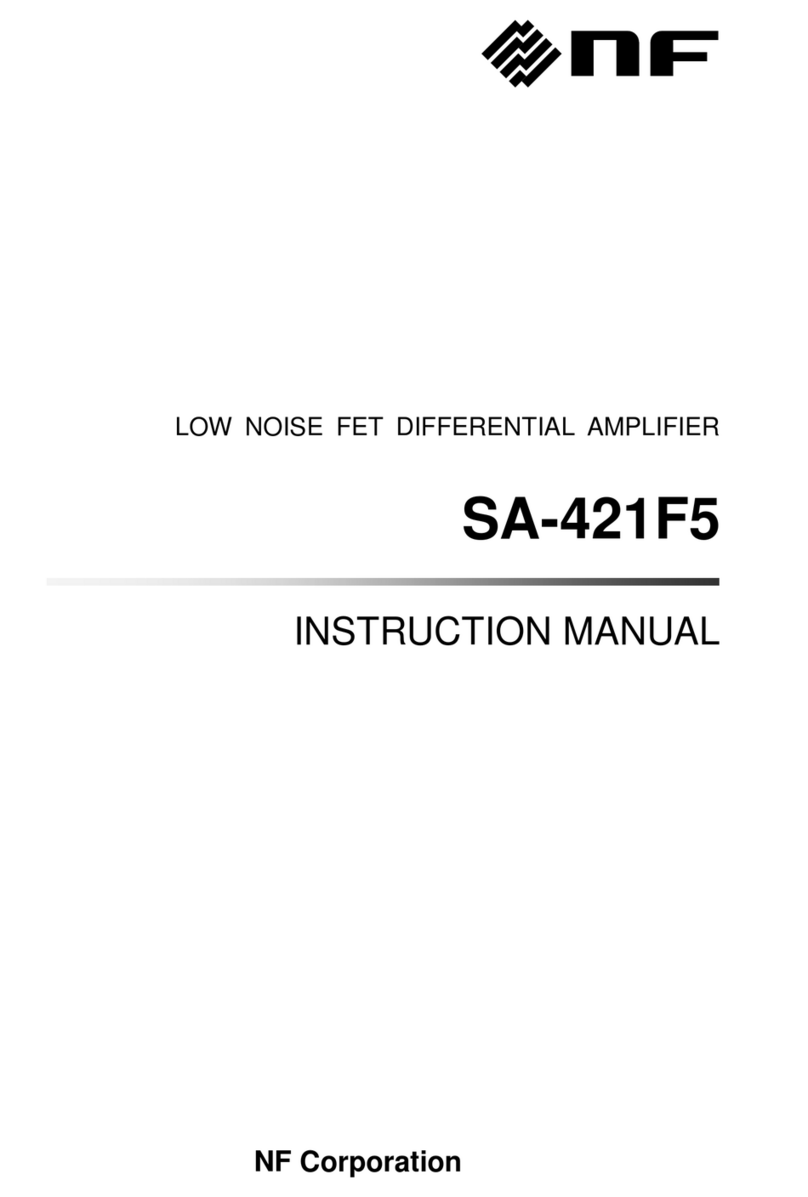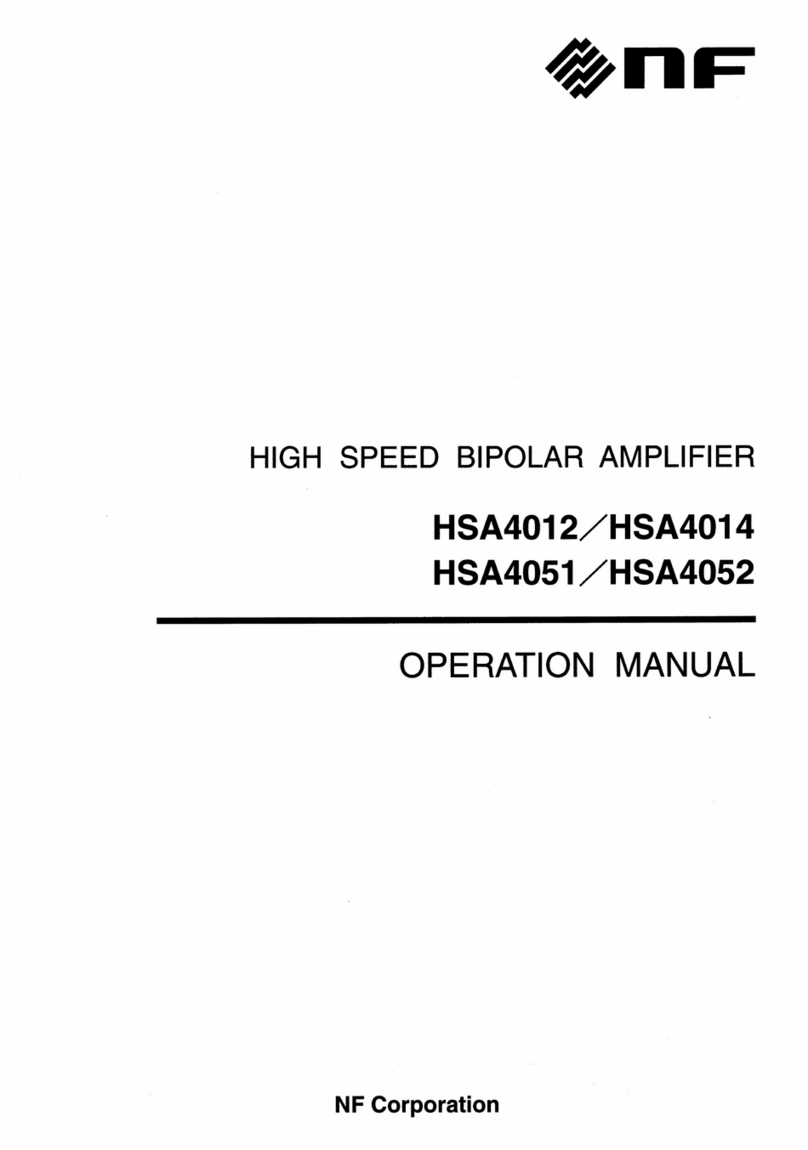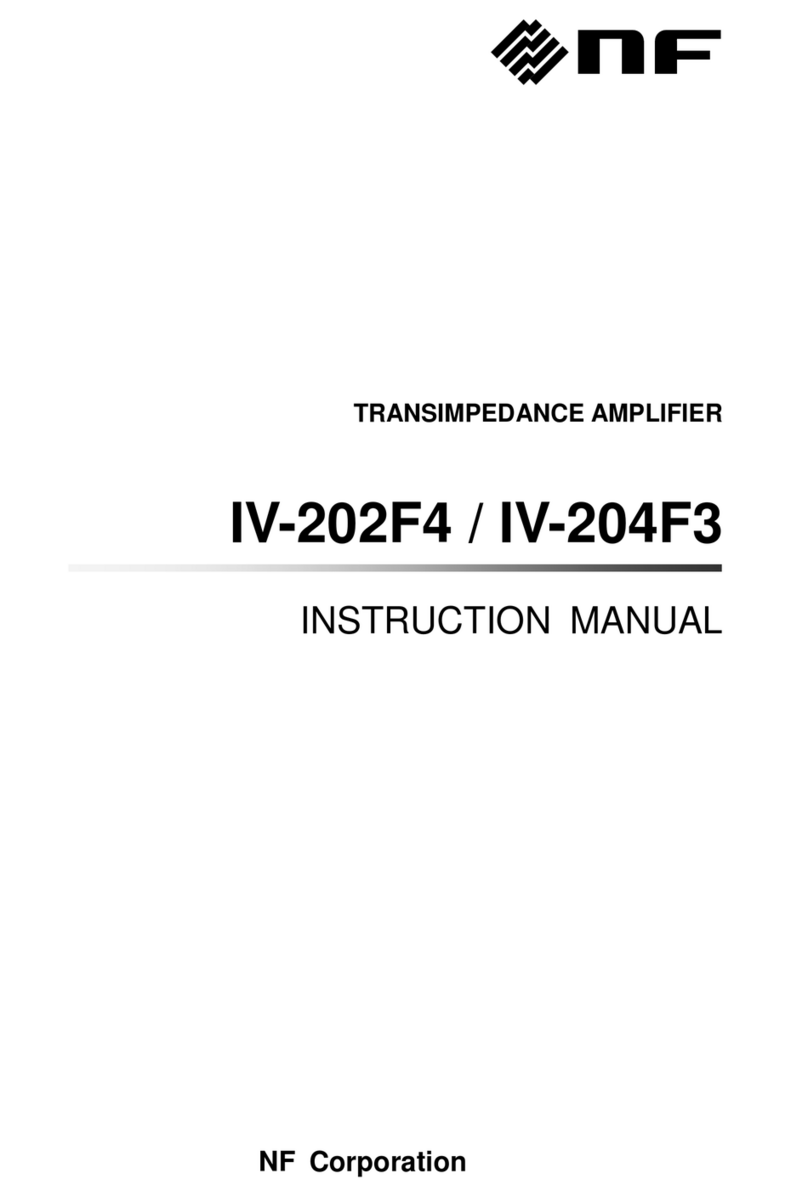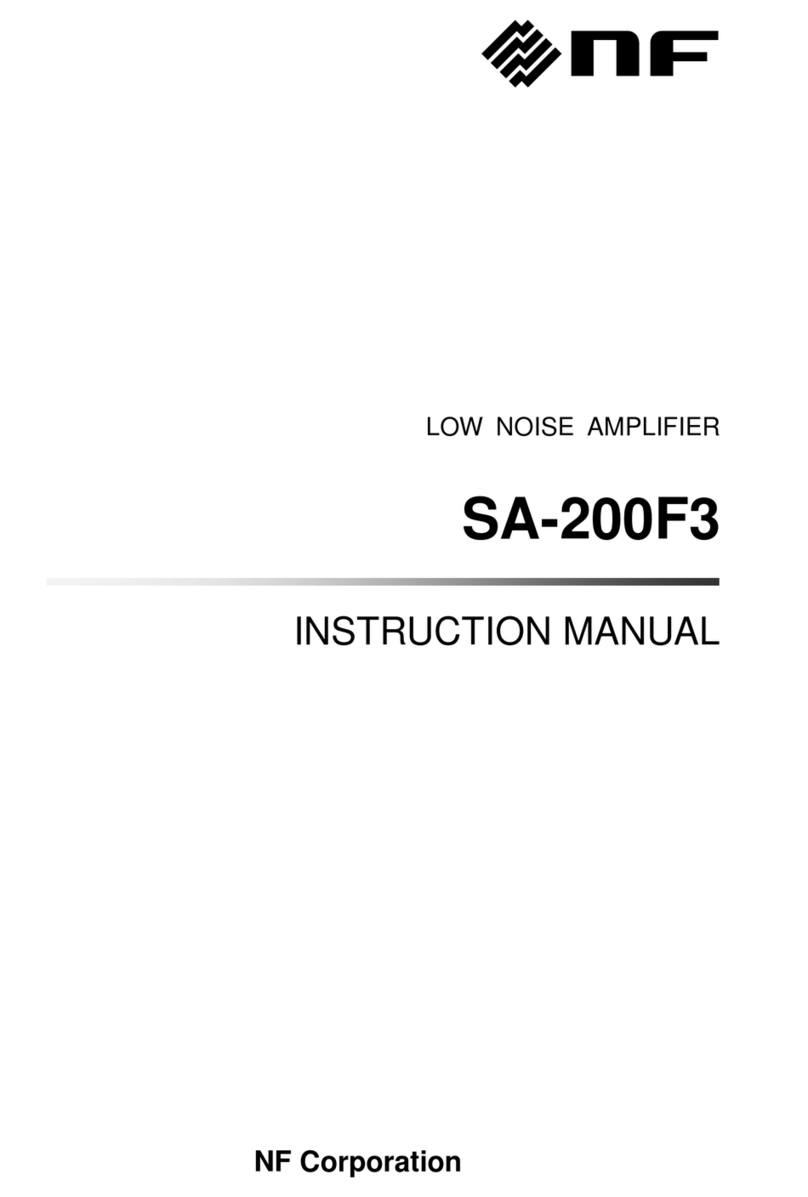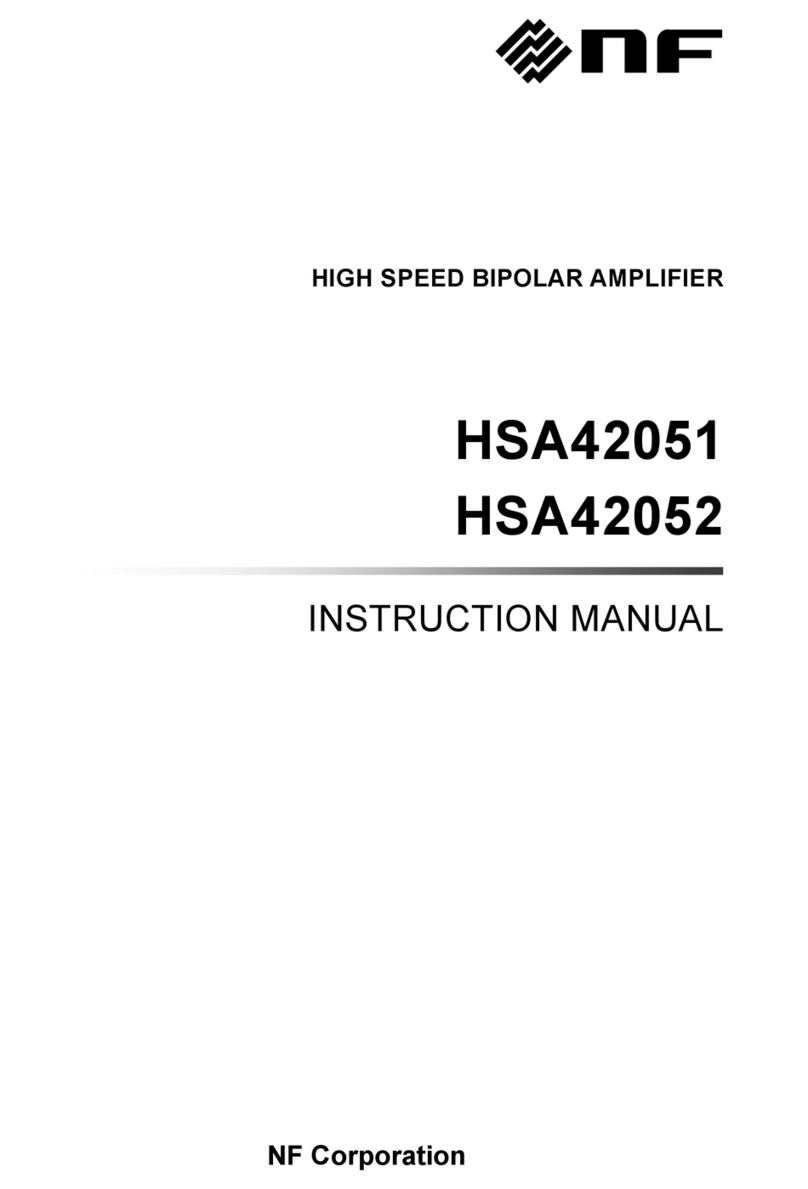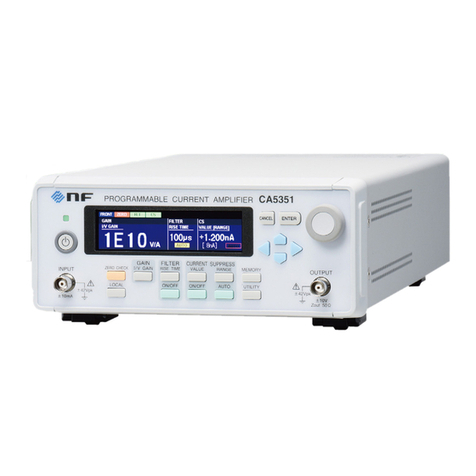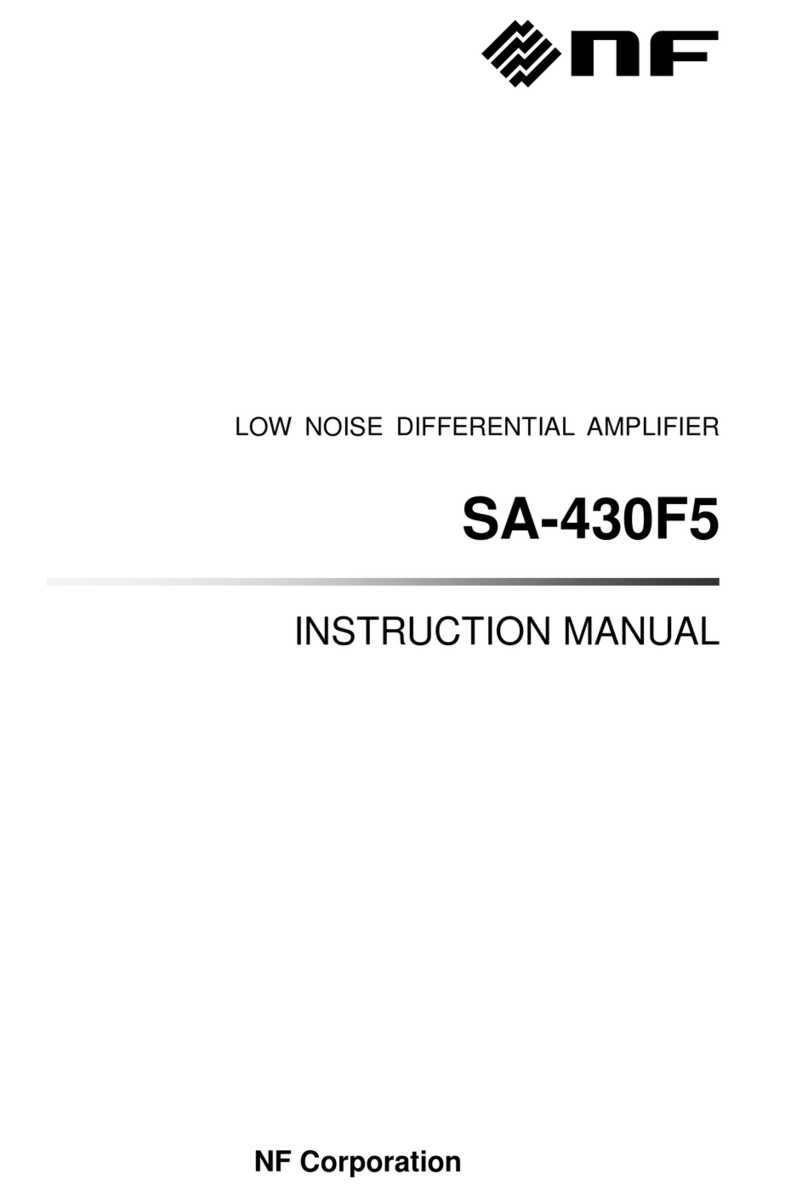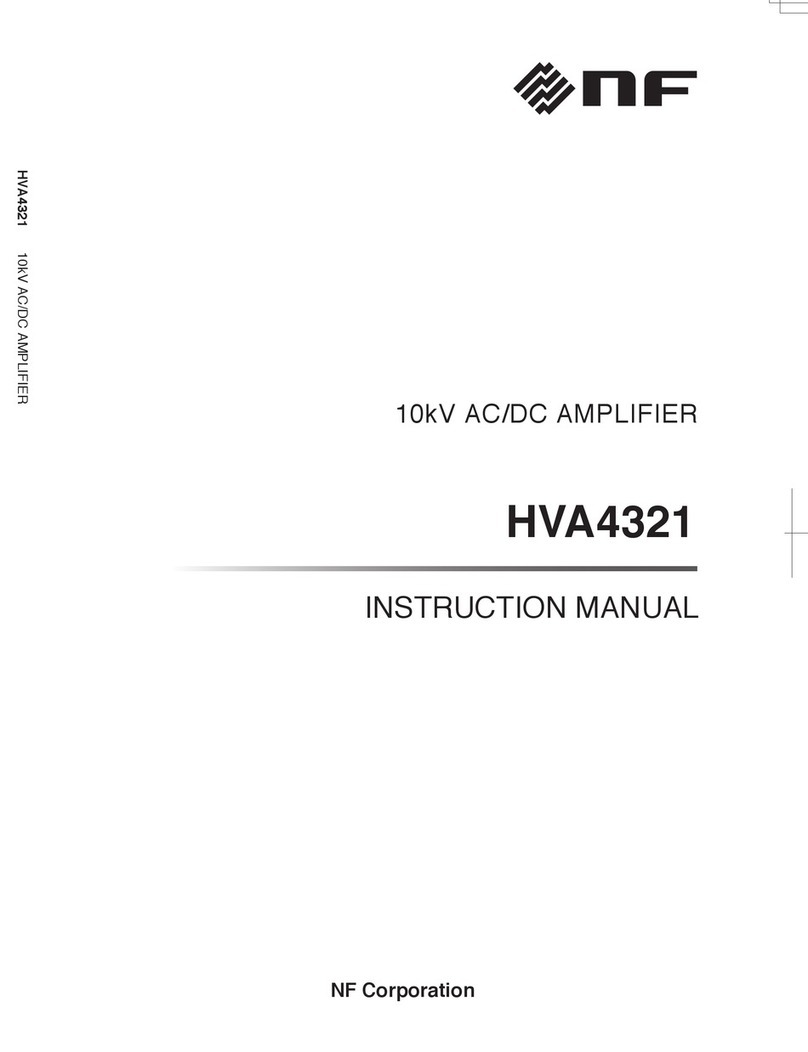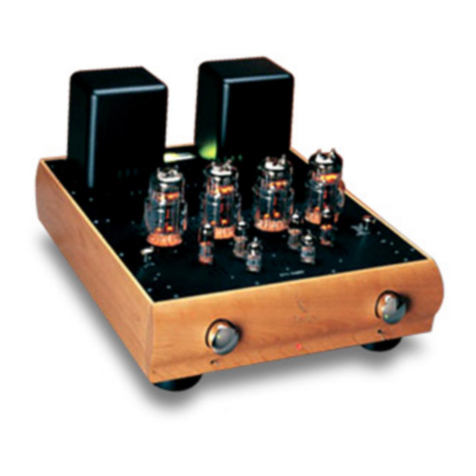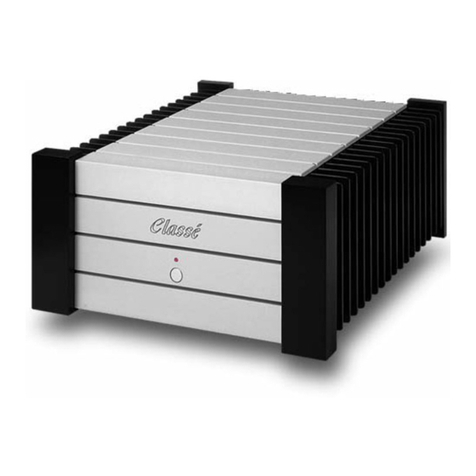NF BA4825 User manual

NF Corporation
HIGH SPEED BIPOLAR AMPLIFIER
BA4825
Instruction Manual


DA00015282-004
HIGH SPEED BIPOLAR AMPLIFIER
BA4825
Instruction Manual


BA4825i
!
Preface
Thank you for purchasing the BA4825 high speed bipolar power amplifier.
To ensure safe and proper use of this electric equipment, please read first Safety Precautions on the
following pages.
Caution Symbols Used in This Manual
The following caution symbols are used in this manual. Be sure to observe these caution
symbols and their contents to ensure the safety of the user and avoid damage to the
equipment.
This mark indicates information for the avoidance of a hazard such as electric shock that may
endanger human life or cause injury during handling of the equipment.
This mark indicates information for the avoidance of damage to the equipment during handling.
This manual has the following chapter organization.
If reading this manual for the first time, start from 1. OVERVIEW.
1. OVERVIEW
Describes the overview, features, applications, functions, and brief operation principles.
2. PREPARATIONS BEFORE USE
Describes various cautions regarding preparations to be made before using the BA4825.
3. PANEL FEATURES AND BASIC OPERATIONS
Describes features, behavior, and basic operation of panel knobs. Read this chapter while
operating the device.
4. ADVANCED OPERATIONS
Describes advanced operations.
5. TROUBLESHOOTING
Describes error messages and countermeasures to be taken when a failure is likely to have
occurred.
6. MAINTENANCE
Describes how to store, re-pack, and transport the device, how to run the performance test,
and so on.
7. SPECIFICATIONS
Describes the specifications including functions and performance.
!CAUTION
WARNING

BA4825ii
Safety Precautions
To ensure safe use, be sure to observe the following warnings and cautions.
NF Corporation shall not be held liable for damages that arise from a failure to observe these warnings
and cautions.
This product is a Class 1 product (with protective conductor terminal) that conforms to the JIS and IEC
insulation standards.
Be sure to observe the contents of this instruction manual.
This instruction manual contains information for the safe operation and use of this product.
Be sure to read this information first before using this product.
All the warnings in the instruction manual must be heeded to prevent hazards that may cause major
accidents.
Be sure to ground the product.
This product uses a line filter and must be grounded to avoid the risk of electric shock.
To prevent electric shock, be sure to safely implement grounding according to Japanese Standard
for Electrical Equipment Technology D (Type 3) or higher.
This product is automatically grounded when its 3-prong power supply plug is connected to a
3-prong power outlet with a protective-ground contact.
This product does not come with a 3-prong to 2-prong conversion adapter. When using a separately
sold 3-prong to 2-prong conversion adapter, be sure to connect the grounding wire of the adapter to
the grounding terminal next to the outlet.
Check the power supply voltage.
This product operates on the power supply voltage indicated in Grounding and Power Supply
Connection in this instruction manual.
Prior to connecting the power supply, check that the voltage of the power supply matches the rated
power supply of the product.
In case of suspected anomaly
If this product emits smoke, an abnormal smell, or abnormal noise, immediately power it off and
stop using it.
If such an anomaly occurs, do not use this product until it has been repaired, and immediately report
the problem to the location of purchase (either NF Corporation or your distributor).
Do not use this product when gas is present.
An explosion or other such hazard may result.
Do not remove the cover.
This product contains high-voltage parts. Absolutely never remove its cover.
Even when the inside of this product needs to be inspected, do not touch the inside. All such
inspections are to be performed by service technicians designated by NF Corporation.
Do not modify this product.
Absolutely never modify this product, as this may cause new hazards and may disqualify this
product from repair in case of failure.

BA4825iii
Avoid output voltage electric shock
The maximum output of the BA4825 is ±250 V.
Make every effort to avoid an electric shock.
Directly touching the output or changing cable connections while output is on may cause electrical
shock.
Do not expose this product to water.
When this product is used in wet condition, it may cause an electric shock and a fire. If this product
is exposed to water, unplug the power cord immediately, and contact NF Corporation or one of our
representatives.
If lightning occurs, power off this product and unplug the power cord.
A lightning may cause an electric shock, a fire and a failure.
Safety-related symbols
The general definitions of the safety-related symbols used on this product and in the instruction
manual are provided below.
Instruction Manual Reference Symbol
This symbol is displayed to alert the user to potential danger and refer
him/her to the instruction manual.
Electric Shock Danger Symbol
This symbol indicates locations that present a risk of electric shock under
specific conditions.
Protective Ground-Terminal Symbol
This symbol identifies a pin that must be grounded to avoid an electric
shock.
Before operating the device, be sure to safely implement grounding
according to Japanese Standard for Electrical Equipment Technology D
(Type 3, 100 or lower) or higher.
Warning Symbol
This symbol indicates information for avoiding danger to human life or
bodily injury while handling this product.
Caution Symbol
This symbol indicates information for preventing damage to the product
when handling it.
Other symbols
This symbol indicates the “on” position of the power switch.
This symbol indicates the “off” position of the power switch.
This symbol indicates that the external conductor of the connector is connected to
the case.
This symbol indicates that the external conductor of the connector is connected to
the signal ground.
!
CAUTION
!
WARNING
!

BA4825iv
Notes for Disposal
When disposing of this product, ask a company that handles industrial waste, to ensure
environmental protection.

BA4825v
Contents
1. OVERVIEW ..................................................................................................................... 1-1
1.1 General .................................................................................................................... 1-2
1.2 Features .................................................................................................................. 1-3
1.3 Applications ............................................................................................................ 1-4
1.4 List of Functions .................................................................................................... 1-4
1.5 Principle of Operation ............................................................................................ 1-5
2. PREPARATIONS BEFORE USE ..................................................................................... 2-1
2.1 Checking Before Use.............................................................................................. 2-2
2.2 Setup and Installation ............................................................................................ 2-3
2.3 Grounding and Power Supply Connection ........................................................... 2-5
2.4 Simplified Operation Check ................................................................................... 2-6
2.5 Calibration............................................................................................................... 2-9
2.6 Radio Law ............................................................................................................. 2-10
3. PANEL FEATURES AND BASIC OPERATIONS.......................................................................... 3-1
3.1 Panel Component Designations and Operations ................................................. 3-2
3.1.1 Front panel .......................................................................................................... 3-2
3.1.2 Rear panel............................................................................................................ 3-3
3.2 Indications at Power-on and Initialization ............................................................ 3-4
3.3 I/O Terminals ........................................................................................................... 3-4
3.3.1 Input connector: A (front)/B (rear)...................................................................... 3-4
3.3.2 Main output.......................................................................................................... 3-5
3.3.3 Monitor output..................................................................................................... 3-6
3.3.4 External control I/O ............................................................................................. 3-6
3.4 I/O Connection ........................................................................................................ 3-8
3.4.1 Signal generator.................................................................................................. 3-8
3.4.2 Signal cords ........................................................................................................ 3-9
3.4.3 Load ..................................................................................................................... 3-9
3.5 Examples of Basic Operations ............................................................................ 3-10
3.5.1 Input selection and input impedance selection ............................................... 3-10
3.5.2 Voltage range selection .................................................................................... 3-10
3.5.3 Output voltage adjustment ............................................................................... 3-11
3.5.4 Fine output offset adjustment .......................................................................... 3-11
3.5.5 DC bias addition................................................................................................ 3-12
3.5.6 Output polarity switching ................................................................................. 3-12
3.5.7 Output voltage monitoring................................................................................ 3-13
3.5.8 Output on/off control ........................................................................................ 3-14
3.6 Setting at Power-on.............................................................................................. 3-14
4. ADVANCED OPERATIONS............................................................................................. 4-1
4.1 Maximum Output Current and Operation Range .................................................. 4-2
4.2 Increasing of Output .............................................................................................. 4-5
5. TROUBLESHOOTING..................................................................................................... 5-1
5.1 Error Messages....................................................................................................... 5-2
5.1.1 Errors at Power-on .............................................................................................. 5-2
5.1.2 Errors related to the protection function ........................................................... 5-3
5.2 When Fault Symptoms Are Observed ................................................................... 5-5
6. MAINTENANCE .............................................................................................................. 6-1
6.1 Introduction ............................................................................................................ 6-2
6.2 Daily Maintenance .................................................................................................. 6-3
6.3 Storage, Repacking, and Transportation .............................................................. 6-4
6.4 Performance Testing .............................................................................................. 6-5
6.4.1 Measurement of maximum output voltage......................................................... 6-6
Page

Contents
BA4825vi
6.4.2 Measurement of maximum output power........................................................... 6-7
6.4.3 Measurement of frequency characteristics ....................................................... 6-8
6.4.4 Measurement of gain error ............................................................................... 6-10
6.4.5 Measurement of sine wave distortion factor ................................................... 6-11
6.4.6 Measurement of bias-added voltage ................................................................ 6-12
7. SPECIFICATIONS ........................................................................................................... 7-1
7.1 Input ........................................................................................................................ 7-2
7.2 Output ..................................................................................................................... 7-3
7.3 Monitor Output........................................................................................................ 7-8
7.4 Protection Function................................................................................................ 7-8
7.5 External Control I/O................................................................................................ 7-9
7.6 Output On/Off Control ............................................................................................ 7-9
7.7 Setting at Power-on.............................................................................................. 7-10
7.8 Power Input ........................................................................................................... 7-10
7.9 Safety and EMC .................................................................................................... 7-10
7.10 Ambient Temperature Range, Ambient Humidity Range, Etc. ........................ 7-11
7.11 External Dimensions and Weight...................................................................... 7-12

BA4825vii
Figures
Figure 1-1. Block Diagram .................................................................................................................. 1-5
Figure 2-1. Standard Connection Diagram ........................................................................................2-7
Figure 3-1. BA4825 Front Panel ......................................................................................................... 3-2
Figure 3-2. BA4825 Rear Panel........................................................................................................... 3-3
Figure 3-3. External Control I/O ......................................................................................................... 3-7
Figure 3-4. Basic Connection Diagram .............................................................................................. 3-8
Figure 3-5. CAL Position of Control for Fine Adjustment (VAR)..................................................... 3-11
Figure 3-6. Center Position of Offset Fine Adjustment ................................................................... 3-11
Figure 4-1. Operation Range (50 V to +250 V range) ....................................................................... 4-2
Figure 4-2. Operation Range (150 V range) ..................................................................................... 4-3
Figure 4-3. Operation Range (250 V to +50 V range) ....................................................................... 4-3
Figure 4-4. Current Waveform Asymmetric with Regard to Polarity ................................................ 4-4
Figure 4-5. Connection of Two BA4825 Units .................................................................................... 4-5
Figure 6-1. Air Filter Cleaning Procedure .......................................................................................... 6-3
Figure 6-2. Measurement of Maximum Output Voltage ..................................................................... 6-6
Figure 6-3. Measurement of Maximum Output Power ....................................................................... 6-7
Figure 6-4. Measurement of Frequency Characteristics ................................................................... 6-9
Figure 6-5. Measurement of Sine Wave Distortion Factor .............................................................. 6-11
Figure 6-6. Measurement of Bias-Added Voltage ............................................................................ 6-12
Figure 7-1. Output Voltage/Current Range (AC) ................................................................................ 7-6
Figure 7-2. Output Voltage/Current Range (DC) ................................................................................ 7-7
Figure 7-3. Ambient Temperature and Humidity Ranges ................................................................ 7-11
Figure 7-4. External Dimensions...................................................................................................... 7-13
Page

BA4825viii
Tables
Table 1-1. List of Functions................................................................................................................ 1-4
Table 2-1. Required Measuring Instruments......................................................................................2-6
Table 2-2. Panel Setting for Operation Check ...................................................................................2-7
Table 3-1. List of External Control I/O Connector Pins ..................................................................... 3-6
Table 3-2. List of DIP Switch Settings.............................................................................................. 3-15
Table 5-1. Diagnosis Performed at Power-on .................................................................................... 5-2
Table 5-2. Errors Related to Protection Function (1/2)...................................................................... 5-3
Table 5-3. Errors Related to Protection Function (2/2)...................................................................... 5-4
Table 5-4. When Fault Symptoms Are Observed (1/2) ....................................................................... 5-5
Table 5-5. When Fault Symptoms Are Observed (2/2) ....................................................................... 5-6
Table 6-1. Judgment of BA4825 Performance ................................................................................. 6-13
Page

BA48251-1
1. OVERVIEW
1.1 General............................................................. 1-2
1.2 Features ........................................................... 1-3
1.3 Applications ...................................................... 1-4
1.4 List of Functions ............................................... 1-4
1.5 Principle of Operation ....................................... 1-5

1.1 General
BA48251-2
1.1 General
The BA4825 is a 50 VA wideband, high-speed bipolar power amplifier with a 2 MHz band capable
of bipolar output of an output voltage and current.
Constant voltage (CV) output characteristics are supported, and the rated output voltage and
current are 100 Vrms and 0.5 Arms, respectively.
Since the BA4825 performs bipolar output, the output voltage and current supply ranges over all
four quadrants. A general DC power supply can supply only positive current (source current) in the
case of positive voltage output. The BA4825, however, can supply both positive and negative
(source and sink) current. The BA4825 can be used with DC, so that an offset waveform or a
waveform asymmetric with regard to polarity can also be amplified.

1.2 Features
BA48251-3
1.2 Features
Wideband, high speed, and large amplitude
The BA4825 has a frequency band from DC to 2 MHz and a slew rate as high as 500 V/
s or more, and
still can output a maximum amplitude of 300 Vp-p.
Low output impedance
With 0.5 + 1.5
H or less (typ.), the load range usable without being concerned about impedance
matching is extended.
Output voltage range switching function
The BA4825 provides three output voltage ranges: 250 V to +50 V, 150 V to +150 V, and 50 V to
+250 V. A desirable range can be selected for an application.
Output polarity switching function
A switch is provided to enable the BA4825 to be switched for use as an in-phase amplifier or a
reversed-phase amplifier.
Protection function
The BA4825 protects against output overload and also protects against power supply faults, abnormal
internal temperatures, and so forth.
Output monitor function
The BA4825 enables output voltage monitoring based on a monitor ratio of 1/100 (BNC connector
output), and also enables output voltage/current checking (switchable, average value indication) with
a meter.
Output on/off function
Output on/off control can be exercised by using the front panel switch or an external control.
Moreover, an output state (output off or output on) at power-on time can be selected using the DIP
switch on the rear panel.
Support of worldwide power supply input voltages
A voltage range from 100 to 230 VAC 10% is supported. The input power factor control (PFC)
function is provided.

1.3 Applications
BA48251-4
1.3 Applications
For testing and characteristics analysis of FEDs, liquid crystals, and so forth
For testing and characteristics analysis of micro actuators and so forth
For use as a booster amplifier for signal generators such as the WF series of NF
Corporation
For use as a power supply for capacitor ripple current testing
For use as an actuator driver
For characteristics testing of diodes and semiconductors such as SCR
For characteristics testing of relays and switches
For use as a power supply for testing in an inspection line for various components
1.4 List of Functions
The table below indicates the major functions of the BA4825.
Table 1-1. List of Functions
Function Description
Input on/off switching Two independent inputs. Two inputs added when
two are on.
Input
Input impedance switching 50 /10 k Two batch-switched inputs.
Output on/off switching
Fine DC offset tuning ±0.5 V
DC bias setting Settable to ±200 V or more.
Settable to on/off.
Output voltage range switching
250 V to +50 V
150 V to +150 V
50 V to +250 V
Gain setting Fixed: 1, 10, 20, 50
Variable: 1 to 3
Output polarity switching In-phase or reversed-phase
Output
Overload protection and
indication
Output voltage monitoring BNC output, monitor ratio 1:100
Monitor Monitor meter Switching output voltage/current display
Other To be set at power-on time Output on/off, gain, and so forth

1.5 Principle of Operation
BA48251-5
1.5 Principle of Operation
The BA4825 consists of a panel block, preamplifier block, power amplifier block, power supply block,
and system control block. "Figure 1-1. Block Diagram" shows the block diagram of the BA4825.
The panel block provides the gain tuning function, input impedance switching function, two-input
addition function, offset tuning function, and bias addition function.
The preamplifier block is a wideband operational amplifier. A feedback technique is employed.
The power amplifier block performs power amplification and has protection functions.
The power supply block consists of the internal power supply block of the BA4825, and the DC power
supply block for the power amplifier with a function for shifting voltage in phase with the output range.
The system control block provides a user interface and interfaces among the blocks.
Figure 1-1. Block Diagram
~LINE 100V-230V
50Hz/60Hz
350VAmax LINE
FILTER
PFC
MODULE
POWER
380Vdc
DC-DC CONV.
MODULE
SUB-DCPS
MODULE
5V
+24V
12V Vdd
Vdd
ERR
V
DD SELECT
ERR
DOUBLE INSULATION +24V
+24V
FAN
FAN
STATUS OUT
CONTROL IN
50
SYSTEM CONTROL CONTROL
I/O
INITIAL SET
MONITOR
1/100
Zout=50
OUTPUT ON/OFF
OUTPUT
±250V MAX
MOTHER
POWER
AMP PROTECT
Vdd
12V
ERR
ATT
PRE-
A
MP
MUTE
A
TT
BIAS
ON/OFF
VDD SELECT
PANEL&ATT
OUTPUT RANGE(V)
+50 150 +250
250 50
BIAS
GAIN
1, 10, 20, 50
CAL←VAR
OFFSET
INPUT B
±10Vmax
INVT
Zin
50/10k
INPUT B
ON/OFF
INPUT A
±10Vmax
INPUT A
ON/OFF
OVLD
METER
V/A
OUTPUT


BA48252-1
2. PREPARATIONS BEFORE USE
2.1 Checking Before Use ........................................ 2-2
2.2 Setup and Installation ....................................... 2-3
2.3 Grounding and Power Supply Connection ......... 2-5
2.4 Simplified Operation Check............................... 2-6
2.5 Calibration ........................................................ 2-9
2.6 Radio Law....................................................... 2-10

2.1 Checking Before Use
BA48252-2
2.1 Checking Before Use
Safety check
To ensure safety in using the BA4825, the user should read the following sections of this
instruction manual before using the BA4825:
"Safety Precautions" (provided at the beginning of this instruction manual)
"2.3 Grounding and Power Supply Connection"
Appearance and accessories check
If an abnormality (such as a flaw or dent) is found on the outside surface of the corrugated box,
carefully check if the product is adversely affected when removing the product from the corrugated
box.
After opening the corrugated box, check the items contained in the box.
If an abnormality such as a flaw or dent is found on the product, or an accessory is missing, contact NF
Corporation or its representative.
Appearance check
Check that no abnormalities such as a flaw and dent are found on the panel, controls, connectors, and
so forth.
Accessories check
The accessories of this product are listed below. Check that there are no missing items and no flaws
are found.
This product contains high-voltage parts. Never remove the cover.
All internal inspections of this product are to be performed only by service technicians qualified by
NF Corporation.
Instruction manual (BA4825 Instruction Manual) 1
Power cord set
(varies depending on destination, 7 A/125 V for Japan) 1
!WARNING
Table of contents
Other NF Amplifier manuals
Popular Amplifier manuals by other brands
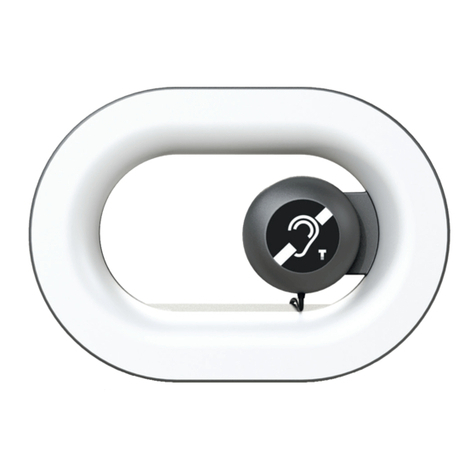
Opus Technologies
Opus Technologies eLoop Installation and user manual
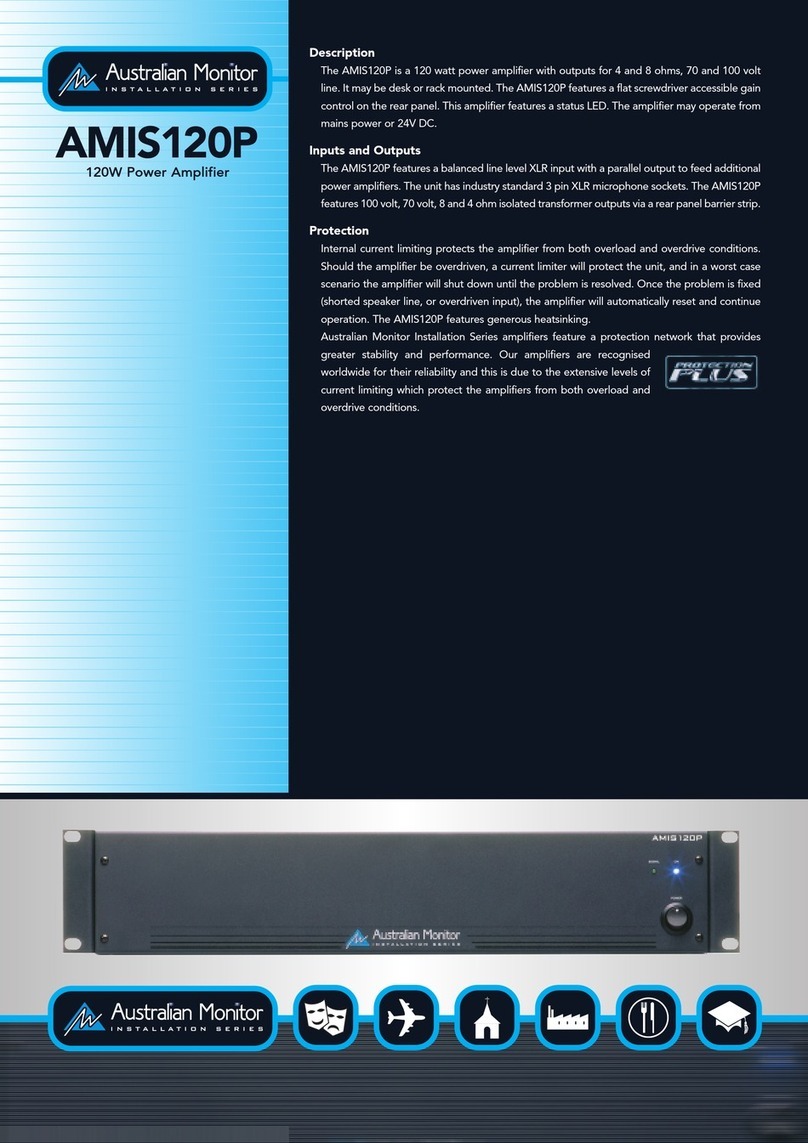
AUSTRALIAN MONITOR
AUSTRALIAN MONITOR AMIS120P specification

Darkglass Electronics
Darkglass Electronics Microtubes 900 V2 owner's manual

McIntosh
McIntosh C-8S instruction manual
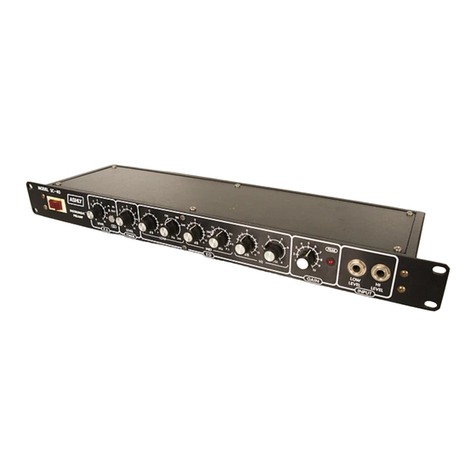
Ashly
Ashly INSTRUMENT PREAMP SC-40 operating instructions
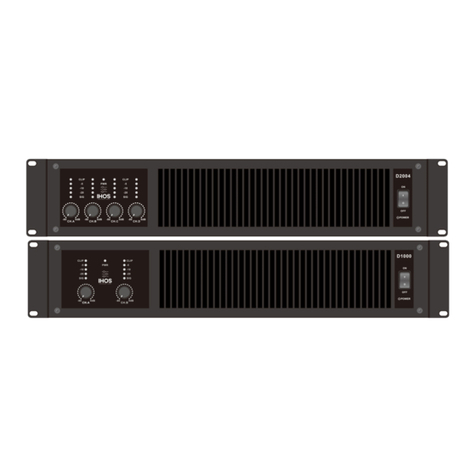
IHOS
IHOS D Series owner's manual
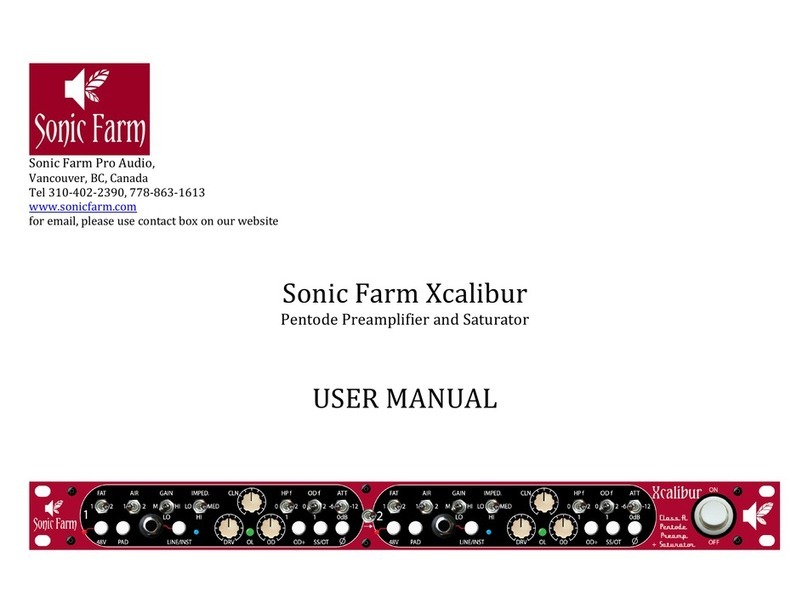
Sonic Farm
Sonic Farm Xcalibur user manual
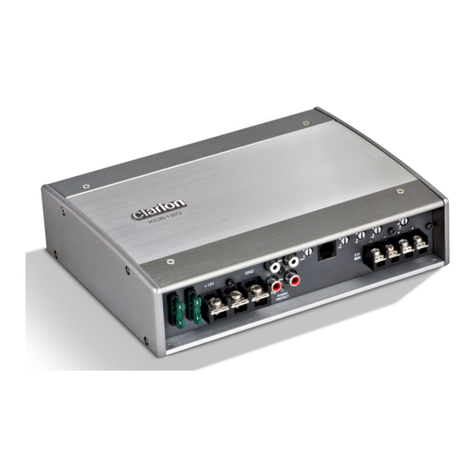
Clarion
Clarion XC6120 Owner's manual & installation manual
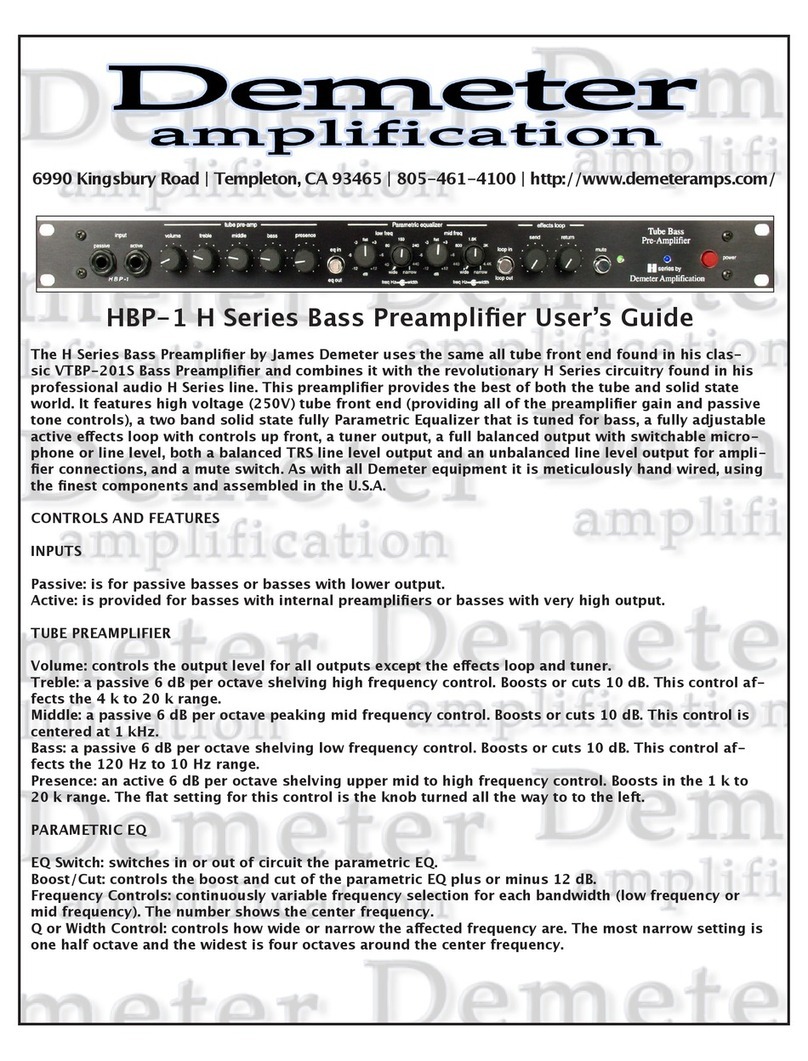
Demeter Amplification
Demeter Amplification HBP-1 H series user guide

thomann
thomann Harley Benton HB-15GXD JamBox user manual
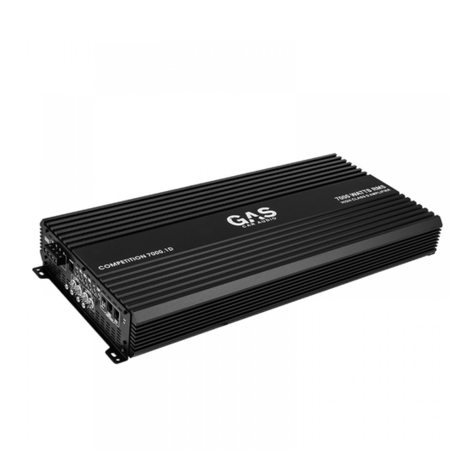
GAS Car Audio
GAS Car Audio COMPETITION 7000.1D owner's manual
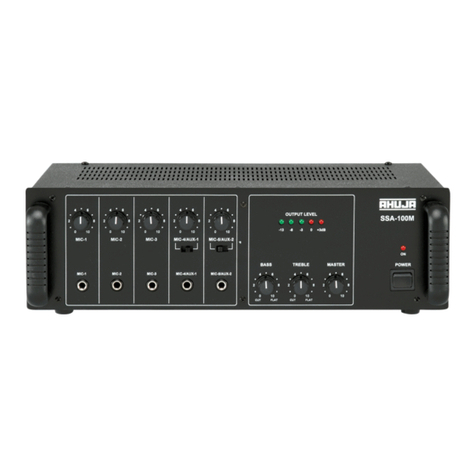
Ahuja
Ahuja SSA-250 M Operation manual


